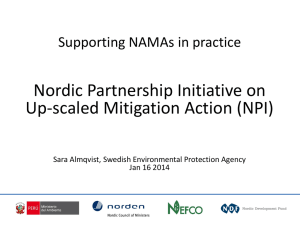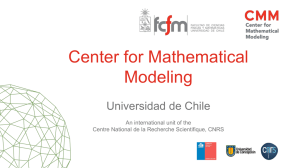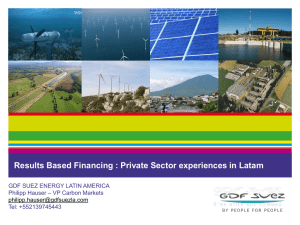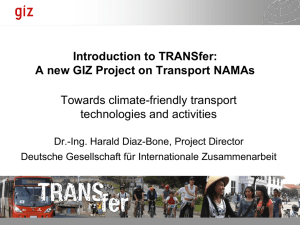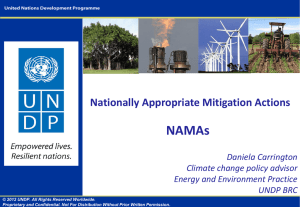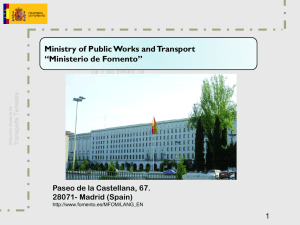Chile - Low Emission Capacity Building Programme
advertisement
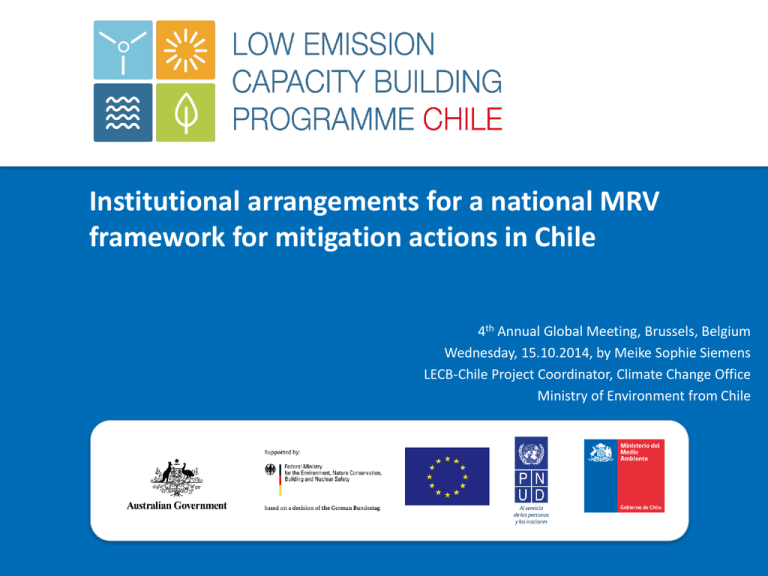
Institutional arrangements for a national MRV framework for mitigation actions in Chile 4th Annual Global Meeting, Brussels, Belgium Wednesday, 15.10.2014, by Meike Sophie Siemens LECB-Chile Project Coordinator, Climate Change Office Ministry of Environment from Chile Experiences from Chile Why does Chile need MRV? What is Chile doing on MRV and how? What are the challenges in MRV? Gobierno de Chile | Ministerio del Medio Ambiente 2 Why does Chile need MRV? • Monitor progress of implementation and effectiveness of plans and national policies • Have clarity on what information needs to be developed and presented to the UNFCCC • Manage and report information related to international (financial) support received in a transparent way Others: NC • • • • Avoid double counting of emission Prioritize sectorial efforts Identify and solve methodological flaws Identify technical and financial needs Gobierno de Chile | Ministerio del Medio Ambiente BUR ICA 3 What is Chile doing on MRV and how? MRV of Chile’s voluntary commitment MRV of national GHG emissions and sinks MRV of other relevant actions MRV of financial support MRV of domestic NAMAs Gobierno de Chile | Ministerio del Medio Ambiente 4 Chile’s voluntary commitment “En base a este sentido de responsabilidad, quisiera reafirmar el compromiso voluntario de Chile de reducir en un 20% sus emisiones proyectadas al 2020, sujeto a apoyo internacional. ” Gobierno de Chile | Ministerio del Medio Ambiente 5 MRV of Chile’s voluntary commitment “Chile will take NAMAs to achieve a 20% deviation below the ‘business as usual’ emissions growth trajectory by 2020, as projected from year 2007. To accomplish this objective Chile will need a relevant level of international support. Energy efficiency, renewable energy, and land use, land use change and forestry measures will be the main focus of Chile’s nationally appropriate mitigation actions.” (August 2010) • Definition of baseline through MAPS Gobierno de Chile | Ministerio del Medio Ambiente 6 What is Chile doing on MRV and how? • MRV of national GHG emissions and sinks • MRV of relevant actions • MRV of financial support • MRV of domestic NAMAs Gobierno de Chile | Ministerio del Medio Ambiente 7 MRV of domestic NAMAs • Climate Change Office in MoE has been developing NAMAs since October 2010 in main emitting sectors • Chile was 1st country to register a NAMA in the UNFCCC Registry • Currently, Chile has 5 registered NAMAs and a portfolio with initiatives in energy efficiency, sustainable construction, agriculture, etc. • Sectorial approach for MRV of NAMAs, but common focus => MRV System as a Management System Gobierno de Chile | Ministerio del Medio Ambiente 8 MRV of domestic NAMAs • NAMA is achieving its objectives? Expected impacts, magnitude, timeframe? • NAMA has un-intended & un-foreseen impacts? • NAMA needs adjustments? Which ones? • Institutional arrangements for a national MRV framework for mitigation actions in Chile (2014) => based strongly on WRI Policy and Action standard, but country-driven process and adapted to specific MRV need in Chile Gobierno de Chile | Ministerio del Medio Ambiente 9 MRV of domestic NAMAs Gobierno de Chile | Ministerio del Medio Ambiente 10 MRV of domestic NAMAs Gobierno de Chile | Ministerio del Medio Ambiente 11 MRV of domestic NAMAs Gobierno de Chile | Ministerio del Medio Ambiente 12 MRV of domestic NAMAs: Gobierno de Chile | Ministerio del Medio Ambiente 13 MRV of domestic NAMAs: Levels of Validation 1. Validation at technical level 2. Validation at political level => Ministerial Committee for Sustainability and Climate Change 1. Validation at technical level Gobierno de Chile | Ministerio del Medio Ambiente 14 MRV of domestic NAMAs: Timeline for Reporting CCO NAMA Developer Biennial Update Report NAMA MRV Plan National NAMA Progress report Biennial Update Report NAMA MRV Plan National NAMA Progress report NAMA progress Report National NAMA NAMA Progress MRV report Plan NAMA MRV Plan NAMA Progress Report 2016 2017 2018 2019 What are the challenges in MRV? • Working on MRV of co-benefits • Identify role of private sector in the development of new NAMAs and the design of its MRV • Developing a national MRV platform • Chilean MRV Guidebook for NAMAs (2015) -minimum standards -common indicators Gobierno de Chile | Ministerio del Medio Ambiente 16 Thank you! Meike Sophie Siemens msiemens@mma.gob.cl MRV of domestic NAMAs Chile’s 5 NAMAs in the UNFCCC Registry Sector NAMA Type Expected reductions Industry/ Energy Clean Production Agreements in Chile 2012-2020 For recognition 18.4 MtCO2e Forestry Implementation of a National Forestry and Climate Change Strategy, including the development and implementation of a Platform for the Generation and Trading of Forest Carbon Credits Seeking support for implementation 42 MtCO2e Energy Expansion of self supply renewable energy systems in Chile Seeking support for implementation 1.7 MtC02e/yr Waste National Program for Catalyzing Industrial and Commercial Organic Waste Management in Chile Seeking support for implementation 12 MtCO2e Transport Santiago Transport Green Zone Seeking support for implementation 1.43 MtC02e Gobierno de Chile | Ministerio del Medio Ambiente 18 “Programme for Minimum Efficiency Performance Standards for residential lighting (MEPS)” -Mapping causal chain -Defining limits Programme of MEPS for residential lighting Restriction on selling of inefficient light bulbs Gradual increase of demand and use of efficient light bulbs Reduction of electricity consumption from the grid Increase of life of light bulbs in houses Increase of import of efficient light bulbs Fostering of national industry producing efficient light bulbs Stopping supply of inefficient light bulbs at selling points Gobierno de Chile | Ministerio del Medio Ambiente Reduction of GHG emissions of the grid Increase of hours of use of light bulbs and other electric appliances Savings in electricity spendings in houses Decrease of frequency of purchase of light bulbs Decrease import of light bulbs from abroad Increase of import of light bulbs abroad Increase in GHG emissins of the grid Secondary effect; no data availability Decrease of GHG emissions due to production and transport of light bulbs abroad Increase in GHG emissions due to production and transport of light bulbs abroad Occurs mainly abroad Increase of GHG emissions due to This effect would happen at manufacturing of efficient very long term and is not of light bulbs in the country Stopping import and national production of inefficient light bulbs main interest Happens Reduction in GHG emissions due to mainly less import of ineffienct light bulbs abroad Reduction of GHG emissions of production of inefficient light bulbs in Chile It is not of main interest and no data availability MRV of domestic NAMAs Process 1: Indicator Selection Step 1 - Causal Chain Gobierno de Chile | Ministerio del Medio Ambiente Step 2 - Assess relevance of impacts Step 3 - Selection of impacts to be MRVd Step 4 - Identify suitable indicators for selected impacts 20 Chile’s Carbon Management Programme: MRV at Facility Level • Development of Carbon Management Programme by the Ministry of Environment from Chile, in the framework of the LECB-Chile project. • Aim: foster, organize, support and monitor the quantification and management of GHG emissions in the public and private sector. • Calculation tool allows to quantify and report emissions of corporations, elaborating a GHG inventory through a web based platform, fulfilling all the requirements of the ISO 14064 (recently converted into a Chilean standard) through standarized reporting frameworks. • Technical support for participating institutions. • Companies are invited to participate on a voluntary and cost-free basis in the pilot testing phase of the calculation tool and collaborate in the design of incentives and the implementation of the programme. Gobierno de Chile | Ministerio del Medio Ambiente 21
